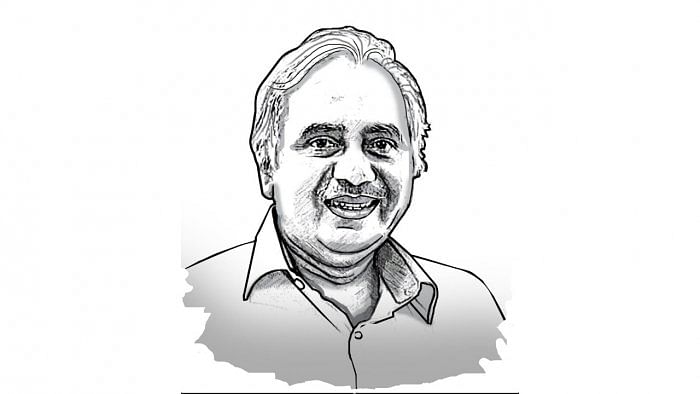
It is difficult to say how the story of US House Speaker Nancy Pelosi’s visit to Taiwan last week will end for the three countries directly involved – the US, China and Taiwan (yes, I don’t have to follow the ‘One China’ policy) -- and for the world at large. Or, perhaps, there will not be an end, rather it is the beginning of a new, more intense phase of US-China rivalry.
The Biden administration sought to downplay Pelosi’s visit by saying that there was no change in the US stand on ‘One China’, but it has also played along with Pelosi. It sent in the aircraft carrier USS Ronald Reagan close to Taiwan to ensure that China would not take any action that could endanger Pelosi herself, while calling the deployment “routine”.
China started to take punitive military and economic actions against Taiwan hours after Pelosi left that country, and it is now feared that Beijing might seek to establish a naval blockade of Taiwan in the guise of carrying out military exercises all around Taiwan. Pelosi has given it a good excuse to do so, if ever it needed one.
For the US, Pelosi’s visit served as a powerful signal to China and the rest of the world that the Superpower can and still intends to stand by allies like Taiwan. It is doubtful whether it will actually rush to defend Taiwan against a full-scale Chinese invasion, but post-Ukraine, it did need to send out a message to its allies that it would. In the bargain, it has established a new level of ambiguity over its commitment to ‘One China’. Beijing’s uncertainty over whether the US will or will not come to Taipei’s defence has only heightened.
Xi Jinping has to act to show his strong disapproval of Pelosi’s visit to Taipei, or else face humiliation at the hands of political rivals and disgruntled elements, especially during the all-important Communist Party conclave in November, where Xi will seek a third term as President, or perhaps even to become President for life.
China’s economy is in no great shape currently, thanks partly to Xi’s own ‘zero Covid’ policies, which have slowed down economic activity. If the US and EU were to join hands to implement even limited sanctions against China, it could send its economy into a tailspin. Besides, any Chinese military action in Taiwan will be met with fierce resistance by the island-nation that has armed itself to the teeth for precisely such an eventuality. Worse, even if Beijing succeeds in subduing Taiwan, it will have done so at the cost of crippling Taiwan’s manufacturing facilities, which are key to China’s white goods industry. That will be a self-goal.
Taiwan contributes to nearly 80% of Chinese white goods production and controls the supply chain. The biggest importer of Taiwan’s electronic wares is China, which then uses these components to maintain its position as the world’s largest producer of electronics and electrical items – China exported $899 billion of these items in 2021. Beijing could punish Taiwan for Pelosi’s visit, for instance through a naval blockade, and cause a huge strain on its economy. But greater the pain that it inflicts on Taiwan, greater will be the cost to its own economy.
Taiwan’s importance lies in its semiconductor industry, not just as a supplier but also in helping the US maintain its technological edge over China. Answering a question at a hearing of the US Senate Foreign Relations Committee on whether the Biden administration would help Taiwan in a conflict with China, Secretary of State Antony Blinken responded that the US had a significant advantage over China in the ability to produce the highest-end semiconductors, quickly adding that the US is determined to make sure that Taiwan has “all necessary means to defend itself against any potential aggression, including unilateral action by China to disrupt the status quo (on Taiwan’ status)”.
Meanwhile, New Delhi should also take note of the White House statement issued in January 2022 highlighting President Biden’s efforts to bring back to the US about 70% of semiconductor manufacturing. If that is the agenda, then would the US have an incentive to protect Taiwan and its industry in the long run?
India should strategise for the future but act now for it. Given the belligerent attitude of China, the PLA’s misadventures in India’s northern border, its untenable claims on Arunachal Pradesh, its continued denial to accept J&K as an integral part of India, its outrageous CPEC projects in POK, New Delhi has every reason to discontinue the ‘One China’ policy. In the immediate, it should join efforts to defuse the situation around Taiwan and safeguard the island-nation.
But more importantly, India has a golden opportunity now to build itself into an economic powerhouse, by stepping up on electronics manufacturing. The Union government has made a beginning by announcing a comprehensive programme for the development of a sustainable semiconductor and display ecosystem, earmarking $10 billion in incentives to promote this industry. But without a practical technology transfer policy, liberal production policies and facilitation, and removing all speed-breakers, the industry will not take off.
Delhi should upgrade trade relations with Taiwan to a high level so as to ensure that India’s fledgling semiconductor fabs begin life at sub-5 nanometre technology. There should be a special fast-tracking cell in the PMO, with representatives from lead ministries, to accord seriousness to the emerging geopolitical and geoeconomics opportunities and challenges.
India is doing better than many other economies amidst the global headwinds. It is time for Delhi to convert what’s now a temporary advantage into a durable one. A strengthening economy and a stable Centre will be key factors in achieving leadership in the emerging new world order.
